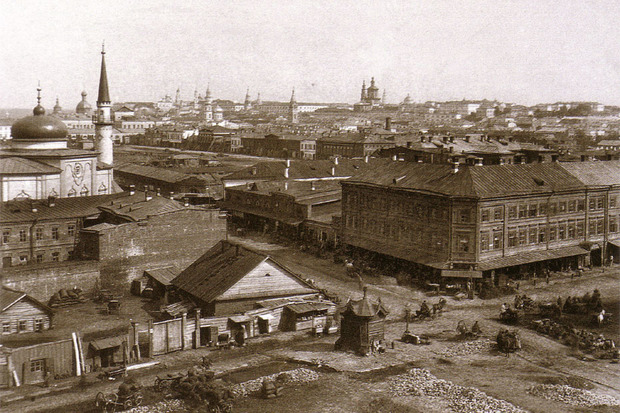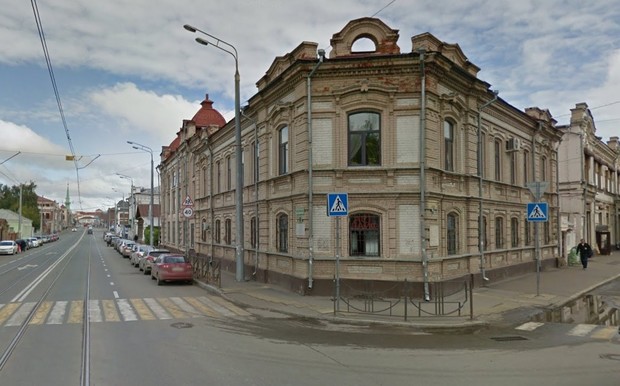‘There were not any luxurious passages in Kazan that belonged to Tatar merchants’
Forerunners of Kazan firms in Staro- and Novo-Tatarskaya Slobodas
A columnist of Realnoe Vremya – historian Liliya Gabdrafikova tells about the main firms of the pre-revolutionary Tatarstan, first attempts of Tatars to create firms, the cult of the golden calf and thoughts in heads of the bourgeois.
Philosophy of Tatar wealth
The accumulation of wealth in the Tatar society never was an inconsistent occurrence with the religious worldview. Wealth was like a God-given gift that an enriched person should share it with his less successful co-religionists.
'A rich Tatar man is an idol of the whole neighbourhood. And this worship often is disinterested <…> the very idea of wealth, nonchalant satisfaction, soft down jackets, fatty dishes and delicacies is what attracts and overrides the Tatars,' an ethnographer N. P. Steinfeld wrote at the end of the 19th century. He supposed that the worship of wealth was connected with the 'materiality' of Islam, where images of the afterlife reminded a rich person's earthly life.
Other authors also stressed the 'bourgeoisie' of the Tatars, in other words, their less inclination to reflection and business activity. And the very Tatar folklore illustrates the inclination of the people to trade.
After the conquest of Kazan Khanate, the majority of the representatives of the noble stratum (Tarkhans, Murzs) were equal to ordinary peasants. So, it was one of the reasons for the bourgeoisie, an aspiration to acquire wealth and desire to differentiate from the others in the society. A concept of 'bast shoes wearing knyazs' appeared. The Muslim spirituality was not a separate stratum. Mullahs belonged to either peasants or lower middle class. This is why wealth was the main yardstick of a person's success. Many famous merchant families belonged to noble kin.
Kazan merchants were especially honoured among the Muslim entrepreneurs of the Russian Empire. The historical meaning of the city and its commercial traditions played their roles. Kazan with its Sennoy Bazaar, beautiful mosques and big madrasa was a centre of attraction of the Tatars from the whole empire. Tatars were engaged in retail trade.

First guild merchant M. A. Apanaev with his wife and daughter. End of 19th – beginning of 20th c. Photo: nik-rech.narod.ru
Such famous dynasties as the Apakovs, Apanaevs, Zamanovs, Yunusovs and others appeared by the beginning of the 19th century. The Muslim merchants sold mainly in Staro- and Novo-Tatarskaya Slobodas (Old and New Tatar Villages). It could be spoken about a peculiar Muslim micro economy with special consumer wants and corresponding offers of 'Asian' commodities and services.
Centre of Tatar trade
Sennoy Bazaar, a large eastern market, existed on the territory of Staro-Tatarskaya Sloboda from the end of the 18th century. In 1849, the 7th Cathedral Mosque (Sennaya, Yunosovskaya or Sennoy Bazaar Mosque) was built on the Yunusov brothers' account.
In 1870, a brick L-shaped building for a public block of shops was erected on the place of chaotically scattered wooden shops on the city authority's initiative. A merchant M. M. Usmanov was the contractor in this business. Unfortunately, after the opening of the new building, ir went broke at the end of the 1870s. Rooms of Amur, Bulgar, Apanaev courtyard (Moscow Rooms) hosted their guests. Editorials of Tatar newspapers, public meetings on different issues took place there. In 1911, a bourgeois Sh. Ishmukhametov opened Svet cinema.
By the beginning of the 20th century, Sennoy Bazaar was a district of revenue houses, hotels, restaurants, inns, hundreds of shops.
According to the dates of historian R. R. Salikhov, 20% of the Tatar population of Kazan belonged to entrepreneurial families at the beginning of the 20th century. In 1914-1916, there were 334 officially registered Tatar commercial and industrial establishments on the territory of Sennoy Bazaar with an annual turnover equal to 14m rubles. Salers of other nationalities and religions, who worked here and on the streets close to the bazaar, owned only 87 enterprises with turnover at a bit more than 2m rubles.

Groceries, merceries, bread, textile, shoe, raw material, tea shops were situated there. Moreover, big earnings of such firms as Ibragim Araslanov and Badretdin Khisamutdinov's heirs, Valiulla Ibragimov with brother, Z.Fakhrutdinov with sons and G.Almetyev were distinguished in food industry. Merchants M.Gaynullin, Sh.Bikkeneyev, S.Z.Khasanov, G.G. Galeyev were big manufacturers. National shoes – luxurious boots and dress shoes from A-K.Z.Sagadeyeva firm – were especially popular among not only the population of Kazan but also other cities. What is more, the firms Sadyk Karimov with brother, M.I.Galeyev with sons and others worked at that time in Sennoy Bazaar. The firm headed by merchant I.G.Utyamyshev, who sold tea and sugar, was one of the largest establishments. Its annual turnover made up 1m rubles.
Apart from the famous merchant surnames, who had a serious capital, in Sennoy Bazaar, there were tens of small of entrepreneurs and peasants of the neighbouring districts. In general, the Muslims actively acted in different spheres of production and trade, exclusive of metalworking, production and sale of alcoholic and tobacco products.
First firms
An aspiration for stationary trade was observed together with bazaar and fair commerce at the turn of the 19th-20th centuries: magnificent passages and new building of firms opened. There were any luxurious passages in Kazan that belonged to Tatar merchants.
Such passages were in other cities of the empire (for instance, the passage of Yakushevs in Troitsk had a lift). Multifunctional buildings of firms were built, which were occupied by shops, storehouses, bureaus and other services. For example, on the corner of Tikhvinskaya and Sennoy Streets (37/20 Tukaevskaya), in the Karimov brothers' firm, there was not only a mercery and textile shop but also the Karimovs' typography with book sale and the first Muslim public reading room in the city.

Caricature image of Tatar bourgeois
It should be noted that despite a big contribution of Tatar entrepreneurs in the development of the national culture, intelligentsia, there was created an unclear collective image of the merchant by the beginning of the 20th century. A bourgeois was often compared with the educated part of the society. For example, there is a record of a humorous story among gramophone records of the beginning of the 20th century called Bourgeois' thoughts performed by a famous actor Gadbulla Kariev. The following type of a Tatar entrepreneur was presented in the story: it is a rich, sly and outwardly religious person whose business was ran by his shop-assistant. An obligatory attribute of the bourgeois is beautiful and expensive clothes, 'karakul hat for 50 rubles', gold diamond ring, three wives, but he goes to 'Mariam' at summer nights especially if old women-intermediaries organize a date…
Bourgeois has to participate in public affairs, but charity contributions depress him. In his view, newspapers are parasites that are ready to make public anything – obviously, shortcomings of a bourgeois' life, first of all.
This record is available on the Internet. You can listen to it here, for instance.
Despite all irony of the record presented, in real life, merchants and their commercial and industrial enterprises played a major role in the development of the culture and consolidation of the Tatar nation. In emperor Russia, only the 'cult of the wealth' could get rid of the complex of a poor 'stranger'.
Reference
Gabdrafikova Liliya – Doctor of Historical Sciences, the main scientific employee of Shigabutdin Mardjani Insitute of History of the Academy of Sciences of the Republic of Tatarstan.